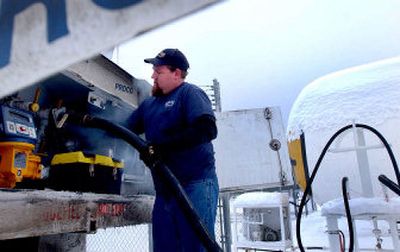Cold snap saps heating help

The last major winter snowfall blanketed the Inland Northwest on Dec. 2, yet more than a week later the drifts remain intact – preserved by the same cold temperatures that are driving low-income and elderly residents to seek aid with their high heating costs.
Public assistance organizations are working to keep the heat on and keep citizens warm even if the temperatures continue to hover below freezing and the cost to heat rises.
As the cold persists, the phones keep ringing at the Community Action Partnership in Coeur d’Alene, which distributes federal Low Income Energy Heating Assistance money to low-income families.
“It’s been difficult,” said Erin Wilkinson, who answers the phones for the agency. “We’ve had to turn a lot of people away from appointments right now. We’re already booked through February.”
The situation is similar in Washington.
Spokane Neighborhood Action Programs, the largest private human services agency in Spokane County, runs more than 30 programs including the Energy Assistance Program. It provides low-income and elderly residents with a one-time heating payment per season, which stretches from October to April.
Robin Waller, a spokeswoman for SNAP, said chilly days and nights have meant a heavy strain.
“It’s going to hit our budget, especially if this cold snap stays, and from everything I’ve heard, it is,” she said.
Since October SNAP has made 4,043 telephone and 493 Internet appointments with clients, and it has dispersed more than $1 million worth of heating payments and almost $16,000 for furnace repair.
SNAP draws on federal, state and private funds to distribute an average payment of $463 this season.
In Idaho, the average payment per household is $253. The state has $11.6 million to distribute statewide, and plans to serve about 34,000 families.
While the amount of federal dollars available for heating assistance is roughly the same as last year – and 10 years ago – the cost of heating homes is going up.
Avista, the largest electric and natural gas utility in the region, raised its natural gas rates this fall by 24 percent and has a request pending to raise its electric rates for residential customers in Washington by 9 percent.
Other sources of heat cost more, too. Propane, for instance, is $1.80 per gallon, 30 cents more per gallon than this time last year, said Wade Edington, general manager of North Idaho Propane in Hayden. That’s $900 to fill a 500 gallon tank.
Despite the cost, Edington said the business has been “swamped” lately with requests for propane, as people burn more to stave off the cold.
He said he doesn’t like raising his price. But when the wholesale price goes up, as it did as soon as Hurricane Katrina hit the Gulf Coast, his prices have to follow.
“People are going to struggle with that. It’s a shame,” he said. “I don’t think there’s any oilman going to heaven.”
For a week, temperatures around the region have stayed below freezing consistently, according to National Weather Service records.
Tracy Cox, a meteorologist with the weather service in Spokane, said the temperature has been unusually cold in the heavily populated areas of the region.
“It looks like it’s going to continue into the next week and beyond,” Cox said.
Waller called the cold weather a “drastic” change from last year’s mild winter.
Barely halfway through the season, SNAP has seen a 48 percent increase in the number of clients seen compared to the same time last year both because of the weather and rising fuel costs. SNAP has added two employees and is therefore processing people quicker.
“There are more people in need because the rates are higher, gas prices are higher and it’s hitting people harder,” she said.
Avista Utilities spokeswoman Catherine Markson said wholesale prices for energy have spiked across the nation. Although Avista’s rates have increased 24 percent as the cold weather has set in, she said the national average rates have increased 41 percent.
“The cost of heat is going up no matter what you’re using,” she said.
She said Avista has struggled to keep its rates down for customers even as the company has paid higher prices for the energy and gas it purchases.
“We know our customers need our help and we’ve got a number of programs, but the biggest thing is to call us if something is going wrong,” Markson said.
The utilities provider has programs that allow customers to receive rebates for energy efficient appliances and that redistribute bills throughout the year. It also contributes to Project Share, an emergency fund that helps keep heating and power from being shut off. Part of that initiative, which also includes SNAP, provides classes to help qualifying low-income residents weatherize their homes.
Many have found simple $40 solutions that would have saved them hundreds of dollars during past years, Waller said.
In Idaho, the Community Action Partnership has weatherization funding for households that earn 150 percent of the poverty level or less.
Russ Spriggs, president of the Idaho chapter of the National Association of Certified Home Inspectors, said a simple, but often overlooked improvement is to insulate the hatch door to the attic, and to weather strip around it.
That prevents heat from escaping into the attic and helps prevent mold from growing in the attic, said Spriggs, who is fielding more calls from people seeking energy saving advice these days.
“There’s a greater awareness in society regarding how much of our pocketbook we spend on energy,” he said.